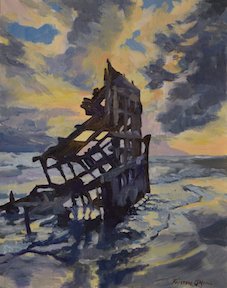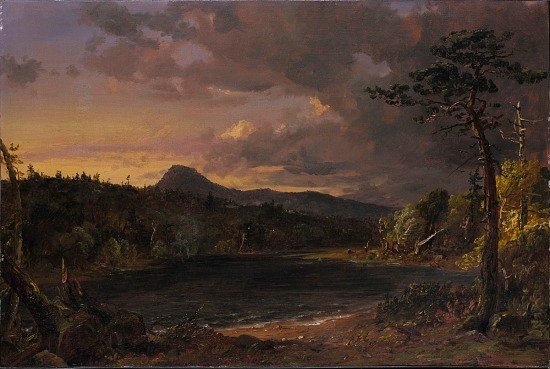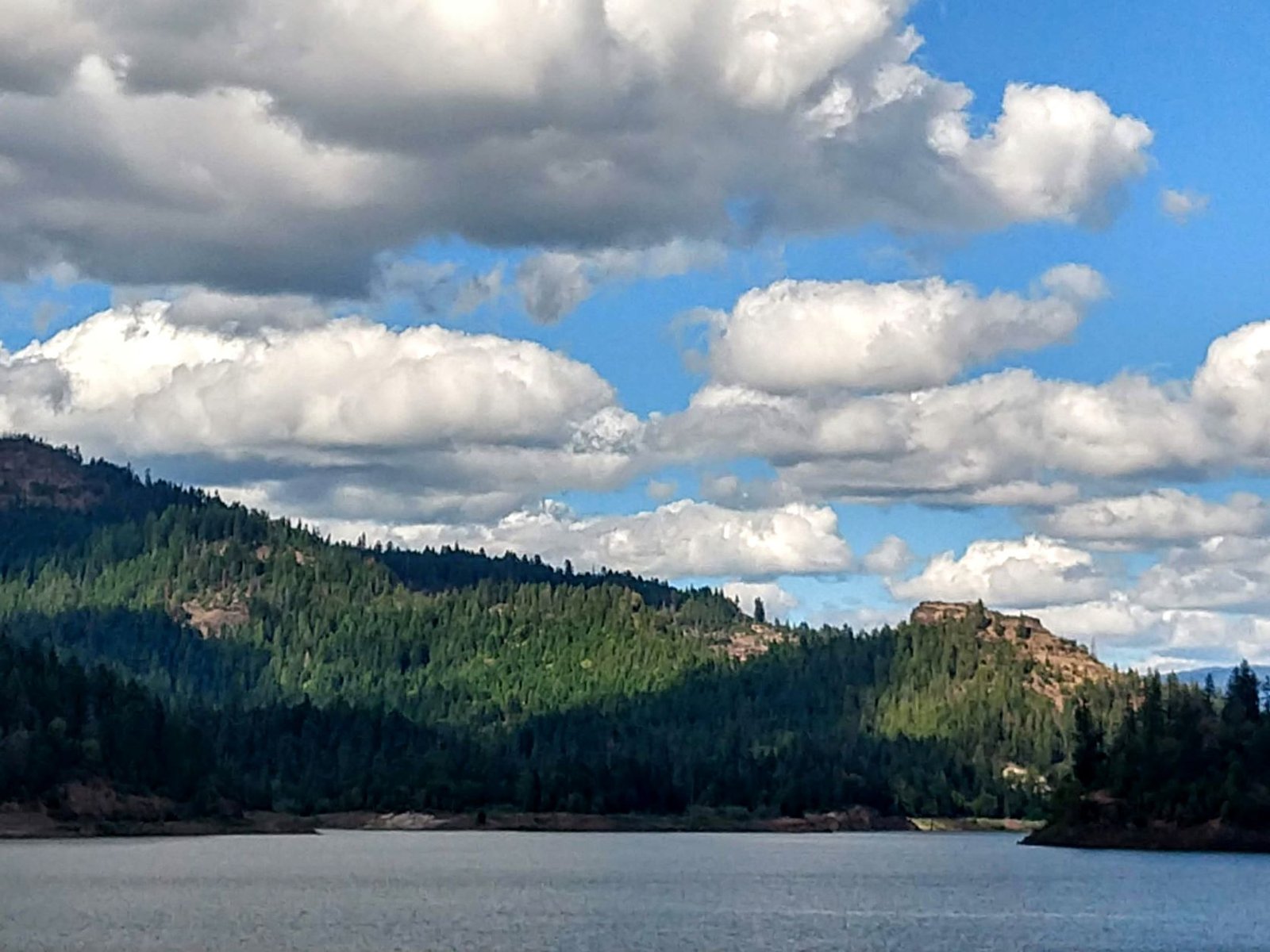
©Kristen O’Neill, Peter Iredale, Oregon Coast Trail series. Acrylic on Paper, 14 x 11 in. Sold. The drama of the storm clouds and the reflection in the water create the mood here.
Clouds exist outside and anything outside usually only has one light source – the sun. (Or, perhaps the moon if painting a nighttime cloudscape.) An early step in painting an outdoor scene is to know what time of day your painting to takes place. This informs the angle of the sunlight (along with color temperature).
Questions to ask yourself:
- What time of day is it?
- What is the weather?
- The season?
- How do I am I showing this visually?
Sunrise and Sunset
The sun is below the clouds – light from the sun is illuminating the underneath part of the clouds. Therefore, the lightest values of the clouds will be on the bottom of the cloud shape. The top of the cloud, where the cloud is the thickest, will have the darker values. The color of the light should also be studied. Sunlight at these times is often more orange than white. The closer to the sun the brighter the clouds are, with the lightest part of the entire painting being the spot in front of the sun (if it is in the pictorial plane). It will also be lighter towards the horizon, as that is where the sun is located.
Daytime – blue skies with puffy white clouds
The typical idea that may come to our minds when we think of clouds is puffy white objects floating in the sky. A good idea is to paint your blue sky first, then work the white on top of the sky. The edges of the paint of the cloud should be on top of the sky to create the effect that the cloud is between you and the dome of the sky. Lighter values are on top – in the direction of the sun. Thin areas of the clouds let the blue show through. Thicker clouds like thunderheads can be more easily painted with an opaque white (Titanium white). Thinner, wispy clouds may need a transparent white (Zinc white).
Weather
The foggier or more of cloudy day – the closer the color of the clouds and the sky are to each other. Also, the less defined the edges of the clouds are. Soft, feathered edges of paint help this effect. The lights and darks of the clouds are fuzzier gradations, then abrupt edges. The angle of the light will be less apparent as the sunlight is refracted more by bouncing off all the water droplets in the air.
Any clouds heavy with water block the light more, and therefore are darker in value. Pollution can also have this effect as it is filled with particles (think smoke from a chimney or a forest fire).
Tips to Try it Out
When you want to paint a realistic cloud scene nature will give you all the clues you need to put together a convincing light and color scheme. Yay! The truth is out there. Okay, now I sound like Moulder on the X-Files… I digress. But seriously, all the answers to your questions are there. Try out these ideas:
- Paint a sunset. You can look through photos you have already taken and use that. Study the photo verses what you see in real life. How is it different? How is it the same?
- Paint a sunny day. Same as in #1, you can use a reference photo if you need. On the next sunny day take a minute to gaze at the clouds. What colors are there? Are they transparent, or opaque? How would you approach painting them?
- Look out a window. What is the light source? Is the light diffused or sharp? How does the light fall upon the things you see outside? In Oregon in the winter, it is likely to be an overcast day, with diffused light. The clouds might sink down upon the hills and reach endlessly and formlessly to the top of my vision. In the summer, giant puffy clouds of every imaginable type can be here. What are your clouds like? How do the clouds help inform the time of day or the season you are painting?
How Have Other Artists Done Clouds?
What do you see in the painting below?

Can you tell the time of the day? Yes – the sun is low in the sky. We know this because there is a spot in the clouds that is much brighter, and the cloud nearest to us is backlit.

In the Catskill Creek painting we can see that it is again sunset time. Notice the angle of the light. The brightest part of the sky is behind the mountain. Where is the darkest? Where does the light catch the clouds? See how the light is bright at the bottom but the sky is violet at the top? When you see paintings that have the same subject matter you are trying to portray study how that artist handled the approach. Here, notice the transition of the colors from the yellow behind the mountain to the sky at the top. This painting avoids a lot of the green that could happen by going from yellow to orange to pink to violet.
I am partial to the giant O’Keeffe painting at the Art Institute of Chicago, Sky Above Clouds IV. The image is under copyright so here is a link to it on the museum’s website. Such a different approach than the above works. That is what makes art great. What are some of your favorite paintings of clouds?



